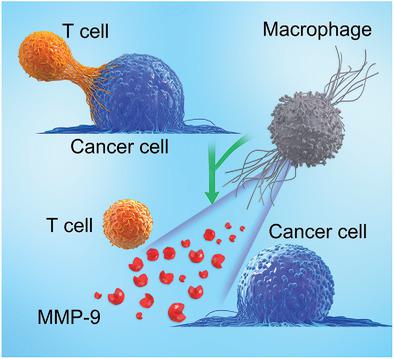Our official English website, www.x-mol.net, welcomes your
feedback! (Note: you will need to create a separate account there.)
Interleukin-33 is a Novel Immunosuppressor that Protects Cancer Cells from TIL Killing by a Macrophage-Mediated Shedding Mechanism
Advanced Science ( IF 14.3 ) Pub Date : 2021-09-05 , DOI: 10.1002/advs.202101029 Jing Wu 1, 2 , Ziqing Chen 3 , Stina L Wickström 3 , Juan Gao 1 , Xingkang He 1, 4 , Xu Jing 1 , Jieyu Wu 1 , Qiqiao Du 1 , Muyi Yang 3 , Yi Chen 3 , Dingding Zhang 1, 5 , Xin Yin 1 , Ziheng Guo 6 , Lasse Jensen 7 , Yunlong Yang 8 , Wei Tao 9 , Andreas Lundqvist 3 , Rolf Kiessling 3, 10 , Yihai Cao 1
Advanced Science ( IF 14.3 ) Pub Date : 2021-09-05 , DOI: 10.1002/advs.202101029 Jing Wu 1, 2 , Ziqing Chen 3 , Stina L Wickström 3 , Juan Gao 1 , Xingkang He 1, 4 , Xu Jing 1 , Jieyu Wu 1 , Qiqiao Du 1 , Muyi Yang 3 , Yi Chen 3 , Dingding Zhang 1, 5 , Xin Yin 1 , Ziheng Guo 6 , Lasse Jensen 7 , Yunlong Yang 8 , Wei Tao 9 , Andreas Lundqvist 3 , Rolf Kiessling 3, 10 , Yihai Cao 1
Affiliation

|
Recognition of specific antigens expressed in cancer cells is the initial process of cytolytic T cell-mediated cancer killing. However, this process can be affected by other non-cancerous cellular components in the tumor microenvironment. Here, it is shown that interleukin-33 (IL-33)-activated macrophages protect melanoma cells from tumor-infiltrating lymphocyte-mediated killing. Mechanistically, IL-33 markedly upregulates metalloprotease 9 (MMP-9) expression in macrophages, which acts as a sheddase to trim NKG2D, an activating receptor expressed on the surface of natural killer (NK) cells, CD8+ T cells, subsets of CD4+ T cells, iNKT cells, and γδ T cells. Further, MMP-9 also cleaves the MHC class I molecule, cell surface antigen-presenting complex molecules, expressed in melanoma cells. Consequently, IL-33-induced macrophage MMP-9 robustly mitigates the tumor killing-effect by T cells. Genetic and pharmacological loss-of-function of MMP-9 sheddase restore T cell-mediated cancer killing. Together, these data provide compelling in vitro and in vivo evidence showing novel mechanisms underlying the IL-33-macrophage-MMP-9 axis-mediated immune tolerance against cancer cells. Targeting each of these signaling components, including IL-33 and MMP-9 provides a new therapeutic paradigm for improving anticancer efficacy by immune therapy.
中文翻译:

Interleukin-33 是一种新型免疫抑制剂,可通过巨噬细胞介导的脱落机制保护癌细胞免受 TIL 杀伤
识别癌细胞中表达的特定抗原是溶细胞性 T 细胞介导的癌症杀伤的初始过程。然而,这个过程可能会受到肿瘤微环境中其他非癌性细胞成分的影响。研究表明,白细胞介素 33 (IL-33) 激活的巨噬细胞可保护黑色素瘤细胞免受肿瘤浸润淋巴细胞介导的杀伤。从机制上讲,IL-33 显着上调巨噬细胞中金属蛋白酶 9 (MMP-9) 的表达,后者充当修剪 NKG2D 的脱落酶,NKG2D 是自然杀伤 (NK) 细胞、CD8+ T 细胞、CD4+ T 细胞亚群表面表达的激活受体细胞、iNKT 细胞和γδ T 细胞。此外,MMP-9 还可裂解黑色素瘤细胞中表达的 MHC I 类分子,即细胞表面抗原呈递复合物分子。因此,IL-33 诱导的巨噬细胞 MMP-9 显着减轻了 T 细胞的肿瘤杀伤作用。 MMP-9 脱落酶的遗传和药理学功能丧失可恢复 T 细胞介导的癌症杀伤作用。总之,这些数据提供了令人信服的体外和体内证据,显示了 IL-33-巨噬细胞-MMP-9 轴介导的针对癌细胞的免疫耐受的新机制。针对这些信号成分(包括 IL-33 和 MMP-9)中的每一个,为通过免疫疗法提高抗癌功效提供了新的治疗范例。
更新日期:2021-11-04
中文翻译:

Interleukin-33 是一种新型免疫抑制剂,可通过巨噬细胞介导的脱落机制保护癌细胞免受 TIL 杀伤
识别癌细胞中表达的特定抗原是溶细胞性 T 细胞介导的癌症杀伤的初始过程。然而,这个过程可能会受到肿瘤微环境中其他非癌性细胞成分的影响。研究表明,白细胞介素 33 (IL-33) 激活的巨噬细胞可保护黑色素瘤细胞免受肿瘤浸润淋巴细胞介导的杀伤。从机制上讲,IL-33 显着上调巨噬细胞中金属蛋白酶 9 (MMP-9) 的表达,后者充当修剪 NKG2D 的脱落酶,NKG2D 是自然杀伤 (NK) 细胞、CD8+ T 细胞、CD4+ T 细胞亚群表面表达的激活受体细胞、iNKT 细胞和γδ T 细胞。此外,MMP-9 还可裂解黑色素瘤细胞中表达的 MHC I 类分子,即细胞表面抗原呈递复合物分子。因此,IL-33 诱导的巨噬细胞 MMP-9 显着减轻了 T 细胞的肿瘤杀伤作用。 MMP-9 脱落酶的遗传和药理学功能丧失可恢复 T 细胞介导的癌症杀伤作用。总之,这些数据提供了令人信服的体外和体内证据,显示了 IL-33-巨噬细胞-MMP-9 轴介导的针对癌细胞的免疫耐受的新机制。针对这些信号成分(包括 IL-33 和 MMP-9)中的每一个,为通过免疫疗法提高抗癌功效提供了新的治疗范例。


















































 京公网安备 11010802027423号
京公网安备 11010802027423号